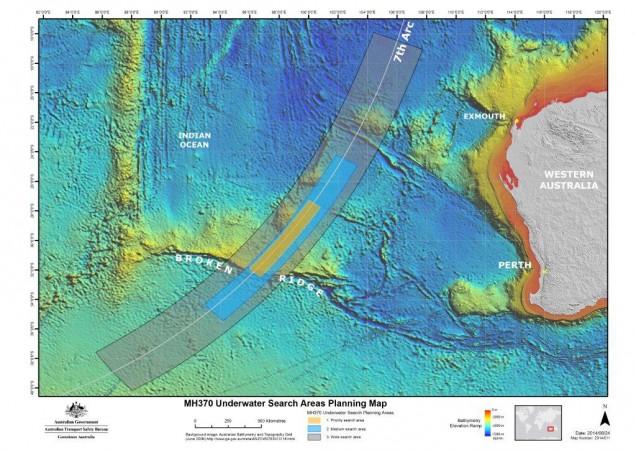
The Australian authorities on Thursday announced that the search area for the missing Malaysian plane MH370 has been shifted further south in the '7th arch' where the aircraft was thought to have ended, based on satellite handshakes or pings.
The Joint Agency Coordination Centre (JACC), which is currently overseeing the search efforts for the doomed airliner, has said that an expert satellite working group has reviewed all existing information in order to define a search zone of up to 60,000 square kilometers along the same arch in the southern Indian Ocean.
Australia's Deputy Prime Minister and Minister for Infrastructure and regional Development Warren Truss said the latest search area had been determined by consultation with experts and specialists from around the world.
"Specialists have analyzed satellite communications information – information which was never initially intended to have the capability to track an aircraft – and performed extremely complex calculations," Truss said in a statement.
"The new priority area is still focused on the seventh arc, where the arcraft last communicated with satellite. We are now shifting our attention to an area further south along the arc based on these calculations," he said, adding that Australian authorities would release a report outlining the bases, on which this latest search area has been defined.
The search will now shift south on an area of 1,800 km off the west coast of Australia, Truss has confirmed, adding that the new area off the western Australian coast will involve a bathymetric survey – or mapping of the ocean floor, the JACC has said.
"The bathymetric survey has already commenced, with the Chinese survey ship Zhu Kezhen and the Australian-contracted vessel Fugro Equator conducting operations in the areas provided by the Australian Transport Safety Bureau," Truss noted.
Flight MH370, on its way to Beijing from Kuala Lumpur, vanished mysteriously into thin air in the wee hours of 8 March with 239 passengers on board. Officials have said that the plane could have been in an autopilot before it eventually crashed, although various news outlets have reported citing circumstantial evidences that it is highly unlikely the plane could be in autopilot.
The widow of the flight's pilot has, in fact, told authors of a book, which describes what might have happened to the ill-fated aircraft, that the last words transmitted from the cockpit were indeed spoken by Captain Zaharie Ahmad Shah. This revelation has pointed the finger of blame squarely to the pilot.
Reports suggested that he was in fact, found to have been practicing flying situations in Southern Indian Ocean and landing in a remote Island, via a simulator in his computer much before he took this flight.


!['Kaise ho bhai..': PM Modi shook hands with Akshay Kumar at a media summit in Delhi [Watch] 'Kaise ho bhai..': PM Modi shook hands with Akshay Kumar at a media summit in Delhi [Watch]](https://data1.ibtimes.co.in/en/full/806317/kaise-ho-bhai-pm-modi-shook-hands-akshay-kumar-media-summit-delhi-watch.jpg?w=220&h=135&l=50&t=40)


!['Kaise ho bhai..': PM Modi shook hands with Akshay Kumar at a media summit in Delhi [Watch]](https://data1.ibtimes.co.in/en/full/806317/kaise-ho-bhai-pm-modi-shook-hands-akshay-kumar-media-summit-delhi-watch.jpg?w=220&h=138)


!['Kaise ho bhai..': PM Modi shook hands with Akshay Kumar at a media summit in Delhi [Watch]](https://data1.ibtimes.co.in/en/full/806317/kaise-ho-bhai-pm-modi-shook-hands-akshay-kumar-media-summit-delhi-watch.jpg?w=220&h=135)


